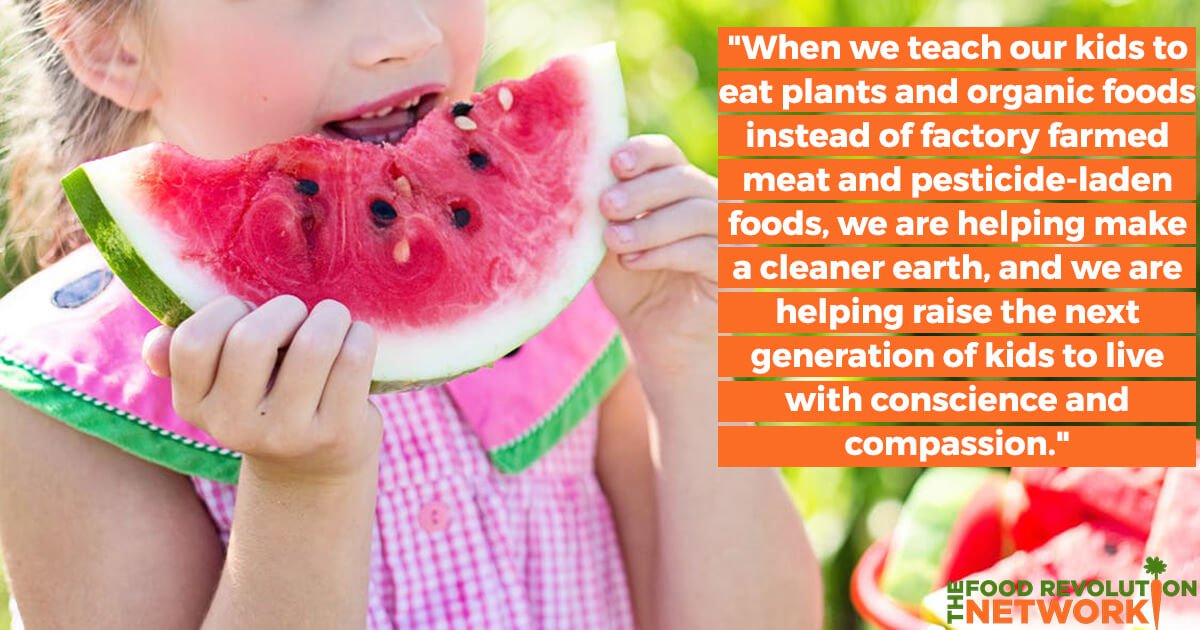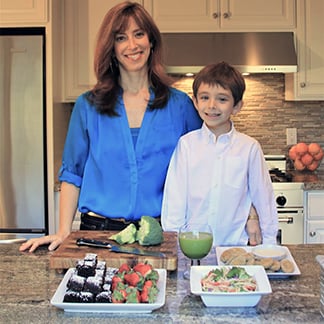Do you want your kids (or the kids in your life) to eat and love healthy foods?
As a mom of a 10-year-old boy, I know how difficult it can be. Sometimes, getting kids to eat healthy food can feel like an insurmountable task, especially in the toxic food environment we live in today. But I’m here to tell you — you’re not alone, and you can do it!
Most parents aren’t feeding their children as well as they think
Most parents today think they are choosing healthy foods for their kids. But are most children actually getting enough of the fruits and vegetables they need?
A 2009 study of 2,000 U.S. mothers and their children called the GENESIS study looked at the quality of preschool children’s diets, as well as their mothers’ perceptions and misperceptions.
According to their findings, almost 83% of the mothers overestimated the quality of their child’s diet.
If your family is eating large amounts of meat and dairy products, and if sugar and packaged, processed foods are a regular part of your diet, it is very difficult to consume enough fruits and vegetables for optimal health.
American children as well as those in many other developed countries, currently consume nearly 90% of their daily calories from animal products and processed foods.
Most children consume less than 10% of their calories from whole plant foods — the foods that many researchers believe are the most important for optimal health. So you may be feeding your kids a lot more healthfully than the average but still falling short of what is truly healthful for them.
This is important, because many chronic diseases begin in childhood, though we may not see their effects until later in life. By the time a typical youngster finishes grade school, the foundation may already be in place for obesity, cardiovascular disease, and diabetes.
But it doesn’t have to be this way!
12 tips to get children to eat and enjoy healthy eating
1) Be a Role Model
The most important thing you can do is focus on your own food choices first. Modeling nutritional excellence is essential. You can’t expect your kids to love vegetables unless you do, too.
The most powerful predictor of children’s dietary patterns is their parents’ dietary patterns. The sooner you start, the better.
More often than not, kids don’t do as we say, they do as we do.
If possible, discuss your health goals with your spouse or partner, and decide on the values you want to model to your children. And then, work together as a team.
2) Eat Family Dinners at the Table
Eating together as a family encourages healthy eating habits. Some families aim for enjoying dinner together at least 4 to 5 times a week. And you may be able to get everyone involved in both cooking and clean-up.
Studies show that family dinners tend to increase the intake of fruits and vegetables, and that families who eat dinner together tend to eat fewer fried foods and drink less soda.
Dining together also has positive social, developmental, and behavioral benefits. Frequent family dinners tend to give children a sense of security and togetherness. Face-to-face interaction can stimulate positive emotions and be a contribution to health and longevity.
So turn off the TV, don’t allow cell phones or other devices at the table, and create positive and meaningful conversations. Taking turns talking and asking kids about their day can help kids (and parents) to feel connected.
3) Don’t Bring Unhealthy Foods into the House
We live in a toxic food environment. We are bombarded with junk food advertising on TV, in magazines, and on the internet. And kids are offered sweets and junk food nearly every day at school. Willpower is not a reliable tool for anyone, especially for kids who are very susceptible to advertising and who are just learning what constitutes a healthy diet.
It’s especially important to create a healthy environment at home. If you haven’t always eaten a healthy diet, now is the time to start. Clean out those cupboards, and replace junk food with healthier options. Make healthy choices, like fruit or cut up veggies that are easy and convenient to grab whenever hunger strikes. Don’t bring junk foods, such as chips, packaged cookies, and soda, into the house. If it isn’t in the house, they (and you) can’t eat it or drink it.
4) Make House Rules About Foods and Beverages (This includes Parents Too!)
In my home, we have a house rule of drinking no more than one sweet drink (100% orange juice) per day. We don’t allow soda or other sugar-sweetened or artificially-flavored or colored beverages (Gatorade, Sunny-D, Capri Sun, etc.) into our house.
Our family also eats a whole food, plant-based diet. You and your family can make the rules and follow the diet and lifestyle that are right for you. Teaching healthy habits, including self-control and healthy boundaries, is important not only with food, but in all aspects of life.
5) Apply Strategies to Stop Picky Eating
- Don’t make separate “kid food.” Some families make teriyaki stir-fry for the parents and chicken nuggets and fries for the little kids. This is not a good idea. If you want your kids to learn to like healthy foods, it’s best to make one meal for the whole family. Most toddlers aren’t ready for kale salads, but many meals can be adapted even for little ones.
- Make new dinners. Rather than making the same dinners that you know your kids like over and over again (mac & cheese again?), get kids in the habit of trying new foods regularly – Thai, Mexican, Ethiopian, Italian, Indian. Let them know they can have familiar favorites, too, but that it’s fun to try new foods.
- Kids have to try one bite. You can let kids know that they don’t have to finish their food, but they do have to try it – that’s part of having good manners. Let them know that it takes time for our taste buds to adjust to new foods. Tell them that foods can taste different depending on how they are cooked, what foods they are served with and how we feel that day – so we may need to try them several times to know if we like them or not.
- WWSE? What Would Superman (or Wonder Woman or LeBron James or whoever they think is cool and smart and strong) Eat? You can ask what their favorite super-hero or athelete or celebrity would eat. You can introduce the idea that super-heroes take super-good care of their bodies and don’t eat junk food.
6) Don’t Tell Kids They Only Get Dessert if They Eat Their Vegetables.
This teaches kids over and over again to hate vegetables by making vegetables seem like a punishment and dessert seem like a reward. A delicious healthy, meal is a reward in and of itself. It helps when you don’t participate in oohing and aahing over the dessert.
If you do enjoy a dessert, let it just be a part of the whole experience, and not made into a big deal. It also helps to not serve dessert every day. If you have desserts a couple times per week (or less), they won’t become habit forming. But if you start serving dessert daily, kids will lose willpower and can become fixated.
7) Make Vegetables More Appealing
According to studies, kids are much more likely to eat vegetables and fruits when parents employ several different tactics.
- Cut vegetables into fun and appealing shapes, like stars.
- Package or serve vegetables with their favorite cartoon character, for instance with an Elmo sticker or on a special character plate.
- Call vegetables a fun name, for instance referring to broccoli as trees.
- Serve vegetables with sauces and dips – peanut sauce, ketchup, teriyaki, maple-mustard, and more. Plain steamed broccoli may be boring to some but drizzled with cashew “cheese” sauce, it can become amazing!
- Cook vegetables in different ways – roasted cauliflower steaks, grilled asparagus with lemon, baked delicate squash served as boats and filled with rice, spinach blended into smoothies – the options are endless!
- Puree vegetables and hide them in recipes. This is a great idea for incorporating more nutrition in recipes.
These efforts may seem like a hassle. You may say to yourself, “I shouldn’t have to do this. My parents made me eat my broccoli and didn’t cut it into special shapes or go to all this extra trouble.” However, kids learn through play. We build habits by creating habit loops – building associations with positive or negative emotions. The more positive emotions we associate with vegetables throughout our childhood, the more likely we are to continue those healthy habits throughout our lives.
8) Get Kids Involved
Kids love to eat foods they prepare themselves. Make healthier versions of familiar favorites and get kids involved in recipe planning and cooking. For instance, using organic ingredients, make homemade baked chickpea nuggets instead of store bought frozen chicken nuggets. Make homemade oven baked sweet potato fries without oil instead of packaged frozen French fries. Teach kids early on all the reasons to eat a whole foods, plant-powered diet – for health, animals, and the environment.
If you’ve been raising your kids on a standard Western diet and are making the switch later on, don’t worry – it can be done! It may seem daunting to “deprive” your kids of their favorite foods – pop, chips, candy, etc. – but sitting down and having a family meeting about the subject can help. Kids are smart and will often be happy to take a leadership role in the way the family eats if simply provided with the information and tools to make informed decisions.
Discuss with your kids how healthy, plant-powered diets are best for their health and the planet. Many kids are more motivated by concerns about animals, the environment, and social equity, than they are about their own personal health. So make sure to tie food choices into what matters and feels real to them.
If they are old enough, your family can watch documentaries like Forks Over Knives and Cowspiracy together. In school from very early on, kids discuss ecological issues and talk about ways to take care of our planet. They focus on the maxim – Reduce, Reuse, and Recycle. This is excellent. However, it may be that the most important thing we can do for the planet is to switch from a diet based around factory farmed animals and laced with chemical, pesticides, and antibiotics, to a diet based around whole and natural plant foods.
When we teach our kids to eat plants and organic foods instead of factory farmed meat and pesticide-laden foods, we are helping make a cleaner earth, and we are helping raise the next generation of kids to live with conscience and compassion.
9) When Dining Out, Choose the BPO (Best Possible Option)
Don’t make the perfect the enemy of the good. When dining out, choose the best possible option for yourselves as parents and for your kids. Sure, homemade and 100% organic is best, but some parents make want to let their kids hang out with their friends and go out for pizza and fast food. You are raising them to be adults and pretty soon, they will be living in the real world, making decisions without you. Depending on your family’s diet context and values, they may want to get a pizza without cheese and lots of veggies, or a bean burrito with guacamole, and without cheese or sour cream, at places like Chipotle or even Taco Bell. Teaching kids how to choose healthier options in the real world is giving them a skill that will serve them for a lifetime.
10) Beware of Kids’ Menus
Kids’ menus are usually filled with hamburgers, hot dogs, pizza, chicken nuggets, French fries and soda – everything a growing body does NOT need to thrive. However, kids’ meals are usually less expensive than adult meals, and many restaurants will make substitutions if you ask, without charging more.
My son is now ten years old and eats adult-sized portions, but when he was younger, we often ordered a veggie burger or spaghetti from the kids’ menu (no meat, no cheese) with a side order of plain steamed broccoli instead of French fries and a water or 100% juice to drink.
11) Read Children’s Books About Healthy Foods
Encouraging literacy in a wide range of subjects is essential for all children. It is tragic how often in our society vegetables are portrayed as “yucky” and “gross,” particularly in children’s books and TV shows. Since my son was born, I have sought out books with themes of fruits, vegetables, and compassion to counter this negative social pressure.
Vegbooks.org is a great resource. You can also find a list of my top 5 favorite children’s books about healthy eating here and another list of my top 10 favorite children’s books here.
12) Be Patient.
It takes time to build new habits. On average, it takes 8-15 tastes of a new food to develop an affinity for it. If kids are used to chicken nuggets and fries, and you’re switching to organic tofu and broccoli, it will take time. But, be positive and be patient. Try presenting foods in new and different ways.
Brian Wansink, a researcher and eating behavior expert at Cornell University, has found that for kids, presentation and attitude are especially important. So, try some of the tips above and remember, your kids won’t starve if they miss a meal or two of their favorite mac and cheese or hot dogs. If they are really hungry, they will be thrilled with foods that might have scared them away before, like Broccoli Cheese Soup or Thai Noodles with Vegetables in Peanut Sauce.
I hope this short list has given you some ideas of how to start your family on the path towards healthier habits.

 The most important thing you can do is focus on your own food choices first. Modeling nutritional excellence is essential. You can’t expect your kids to love vegetables unless you do, too.
The most important thing you can do is focus on your own food choices first. Modeling nutritional excellence is essential. You can’t expect your kids to love vegetables unless you do, too. Don’t make separate “kid food.” Some families make teriyaki stir-fry for the parents and chicken nuggets and fries for the little kids. This is not a good idea. If you want your kids to learn to like healthy foods, it’s best to make one meal for the whole family. Most toddlers aren’t ready for kale salads, but many meals can be adapted even for little ones.
Don’t make separate “kid food.” Some families make teriyaki stir-fry for the parents and chicken nuggets and fries for the little kids. This is not a good idea. If you want your kids to learn to like healthy foods, it’s best to make one meal for the whole family. Most toddlers aren’t ready for kale salads, but many meals can be adapted even for little ones. Kids love to eat foods they prepare themselves. Make healthier versions of familiar favorites and get kids involved in recipe planning and cooking. For instance, using organic ingredients, make homemade baked chickpea nuggets instead of store bought frozen chicken nuggets. Make homemade oven baked sweet potato fries without oil instead of packaged frozen French fries. Teach kids early on all the reasons to eat a whole foods, plant-powered diet – for health, animals, and the environment.
Kids love to eat foods they prepare themselves. Make healthier versions of familiar favorites and get kids involved in recipe planning and cooking. For instance, using organic ingredients, make homemade baked chickpea nuggets instead of store bought frozen chicken nuggets. Make homemade oven baked sweet potato fries without oil instead of packaged frozen French fries. Teach kids early on all the reasons to eat a whole foods, plant-powered diet – for health, animals, and the environment.

